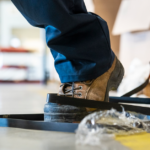What to do when your workplace is flooding and afterward
This blogpost is an abbreviated compilation of Zurich’s When to activate your flood response plan and Flood recovery: What to do when the waters recede and is used with permission from Zurich.
You and your employees have prepared for potential floods as best you can. You checked and shored up your building structure, you backed up all computer files and moved them to a secondary location, you moved equipment and inventory up higher to avoid water damage, and you have a disaster plan in place with extra contractors plus a communication plan for employees, vendors and customers. But what do you do during and after a flood? Glad you asked.
When flooding is imminent
DOCUMENT THE EVENT
- Develop a complete record of all relevant flood details to help facilitate the loss adjustment process for during and after a flood. It provides a record of steps you took that may help your emergency response and site management personnel to improve your mitigation and response plan for any future flooding. Include a record of all internal communications and actions, photos of preparations taken onsite before the event, conditions upon your return and more.
STAY ABREAST OF DEVELOPING CONDITIONS
- Stay in contact with local authorities and emergency services agencies to gauge the status and potential severity of ongoing flood risk. They should be able to provide guidance as to how serious or potentially dangerous the flooding event may become.
INFORM ALL STAKEHOLDERS OF THE SITUATION
- Follow the communication protocols outlined in your Emergency Response Plan for during and after a flood to ensure employees, local authorities, media and others are kept informed of the developing situation.
- Provide all critical information regarding the scope of the event to your staff, customers, suppliers and any others who need to know. Inform suppliers to pause deliveries until otherwise notified.
EXECUTE SAFE SHUTDOWN PROCEDURES
- Critical operations and utilities identified in your Emergency Response Plan should be shut down for the duration of the emergency, according to conditions and parameters outlined in your plan.
REMOVE HAZARDOUS SUBSTANCES TO A SAFE LOCATION
- Make sure that hazardous materials are moved to secure locations using safe access routes identified during the planning process. This not only helps protect your property and people but may also prevent egress of materials into local runoff, potentially resulting in pollution exposures.
REMOVE PORTABLE MACHINERY, EQUIPMENT, STOCKS AND SUPPLIES TO SAFE LOCATIONS
- Critical equipment should be relocated from ground level and below-grade areas following access routes defined during the preparation phase.
Related: Protect your organization from hurricane damage
CLOSE MANUAL SEWER BACKFLOW VALVES AND PLUG DRAINS
- This process should include the plugging of toilets to help prevent sewage backups. Basement and lower-level toilets in areas that may be prone to flooding should be removed and the drains plugged as a part of the response planning process.
ISOLATE LOW-LEVEL ELECTRICAL AND NON-PORTABLE EQUIPMENT
- Equipment that is not portable and cannot be removed must be protected from flood effects by whatever means are available, practical and safe.
SECURE BUILDINGS
- Once all buildings and facilities have been evacuated and secured, restrict entry until the emergency has passed.
After the flood: recovery steps
ACCESS THE SITE
- Your flood aftermath may include toxic spills, building damage and undermined roads or other exterior surfaces. Live electrical lines, shorted wiring and interior electrical systems can energize standing water, creating an electrocution risk.
- Before entering the site, ensure qualified personnel evaluate all risks. Severely damaged areas of a building should be reviewed by a structural engineer. Electrocution is a risk from downed power lines, so treat them as live until a utility provider confirms they are de-energized. Do not reconnect electric or gas until your utility provider has cleared you to do so.
DOCUMENT DAMAGE
- Take photos to document damage to support your claim filing. Before entering the site, equip yourself with the necessary tools and protective gear, as well as drinking water, disinfecting supplies and a first aid kit.
- Consider toting a backup camera along with your fully charged cellphone. Also consider taking a fire extinguisher.
GET THE WORD OUT
- Inform employees, clients, suppliers, local authorities, media, etc., about conditions at the site and expectations on when it may open again for access. Inform public sanitation professionals of any site damage.
INITIATE CLEAN-UP
- Grant site access to begin clean-up operations only after an all-clear from the proper authorities.
- Remove ruined, moisture-soaked objects from the affected buildings and away from exterior walls to facilitate the drying out.
- Dispose of damaged and/or contaminated material according to local regulations.
- Restore HVAC systems or rent or purchase blowers and dehumidifiers to assist in drying out and mitigating mold. Do not use extension cords in wet areas.
HAVE UTILITIES CHECKED
- Power and other utilities should not be restored until inspected by qualified personnel, to ensure employee safety upon resumption of operations and to prevent equipment damage. After getting safety assurances, have electricity and gas services restored.
INFORM YOUR INSURANCE COMPANY
- Call your insurance representative to begin the claims process. Provide photo documentation of damages as well as a diary of events including when the waters entered and how long until they receded. Ask for guidance on which damaged goods can be disposed of, and what should be set aside to be used to support a claim. Maintain contact with your insurer throughout the process.
CHECK PROTECTION SYSTEMS
- Verify that water supplies, fire pumps, automatic sprinklers, fire alarms and security systems are working. Report fire protection system outages. If any of these systems are compromised, make repairs and post security personnel on site.
- Clear roof drains, balcony drains and ground-level catch basins and drains in preparation for further rain. If further floods are predicted in the near term, set up sandbags or other recommended barriers at low level doors and entrances.
CONTACT RESTORATION CONTRACTORS
- A relationship with disaster recovery contractors should be part of your organization’s flood Emergency Response Plan (ERP). After a flood, contact contactors as soon as possible to line up any appointments needed for service. Establish repair priorities based on the level of danger the damage poses. Any contractors onsite must wear proper safety equipment; respirators and chemical protective gloves or suits should be considered.
CONDUCT ENVIRONMENTAL CONTROLS
- If water has been collected in retention pits on the property, test the water for potential contaminants before draining it or releasing it into the environment.
PROTECT YOUR EMPLOYEES
- Employees often support the organization during the cleanup after a flood, but ensure they are kept safe. Stay in regular contact, supply needed protective gear and factor in the possibility of disruptions to suppliers and distributors.
Follow these steps to minimize damage, ensure employee and contractor safety, and to get your organization up and running as quickly as possible.







